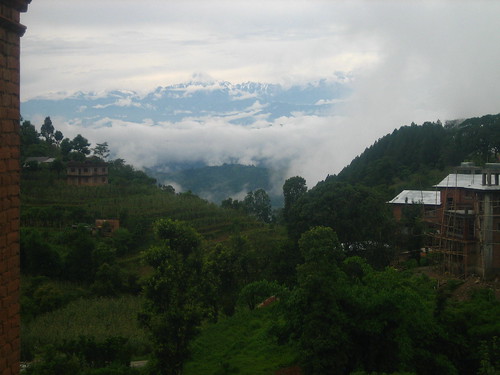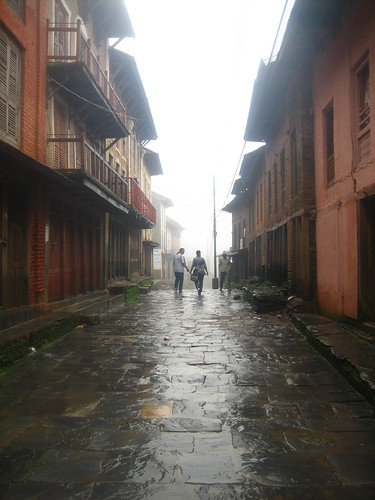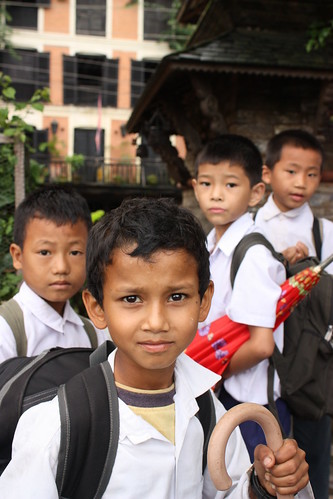Bandipur – National Treasure
The small town of Bandipur is draped, according to the Lonely Planet, like a silk scarf along a high ridge in the hills of Nepal. We were looking for our next destination in Nepal, after being scuppered trying to get to Tansen, and were sold straight away. Well, nearly straight away, we had to do a quick search on the Foreign Office website first as apparently in the not-too-distant past it’s been a hotbed of support for the Maoist uprising here.
Getting there was relatively simple, as we just had to catch one of the many buses that run along the highway from Pokhara to Kathmandu every day, and hop off after a couple of hours. For me this meant no travel sickness tablet, as they usually render me about as awake as a hibernating tortoise, and just about as useful as well, so as we bumped and rocked our way over the poorly-maintained highway I was glad to see the signs for Dumre coming up. Dumre is a dusty little town with not much to recommend it at all, except the fact that the jeeps for Bandipur loiter there, ready to take you 7km up some of the steepest roads and tightest hairpin bends you have ever seen.
Because our plans for Tansen were so cruelly nipped in the bud, we decided to spend the money we would have otherwise spent on getting there/getting a hotel on a really lovely hotel in Bandipur, called The Old Inn. This is one of the old buildings in Bandipur that has been exceedingly carefully restored to its former glory, using traditional crafts, techniques, and materials. It was above budget, but as all meals were included, it wasn’t hard to sell us on it.

Bandipur was originally a bustling market town, an important stop on the India – Tibet trade route. Traders would stay here and take advantage of its malaria-free status, and the town itself prospered. However, in the 1970s, the main Kathmandu – Pokhara highway was built, for logistical reasons, far below in the valley, thereby bypassing Bandipur completely, and the town’s fortunes started a swift decline. However, this one fact that at one time was the doom of Bandipur now appears to become its saviour. It’s virtually completely preserved in its traditional architecture, a quiet, peaceful town where visitors are treated with a cool respect, which is so refreshing after the persistent touts of the bigger cities.
We checked into our amazing room, which was small but perfectly formed, with a balcony leading to views down the valley. And not just the valley – about an hour or so after check in I was reading and Andy was napping when I looked up and out of the balcony window to see the clearest view of the Himalayas we’ve had yet (Monsoon season means cloudier weather and fewer views). After an involuntary exclamation of “Oh wow” out loud, I had to wake Andy up to show him, and we spent about an hour taking woefully inadequate photos that could never show just how beautiful these mountains were.

The next challenge was putting up the mosquito net, a first for both of us, but necessary if we wanted to keep the balcony doors open at night (and we did – I couldn’t resist the thought of those views greeting me in the morning). But where to hang it from? The ever-so-useful hooks I’d bought from Wilko’s before we left were about as much good as a chocolate frog in a heatwave, refusing to stick to either the wooden beams or the plaster ceiling. Any fixtures and fittings were making the net either far too low or far too high, rendering it completely useless. Finally, after some perserverence and making good use of our Swiss Army knife (again, a first, apart from the corkscrew attachment), we managed to lodge it in the wooden beams overhead. Mozzie free!

After this mission, we set off round the town to stretch our legs and to take in some of the architecture. There are a couple of specific sights mentioned in our guidebook, but for the most part, the biggest charm in Bandipur was just wandering and getting lost in the winding streets. Our first recce took us out past some in-tact Newari houses, still being used exactly for the purpose for which they were intended, and past the (slightly incongruous in this setting) Notre Dame School, set up by Catholic nuns and, from the evidence we saw by meeting some of the children around town, they are doing a fine job in educating the young people of Bandipur. Apparently the school was shut in 2001 after some pressure from Maoists, but re-opened in 2003.
We wandered out again past hills and farms, enticed by the sight of a woman tending goats, and the sheer amount of chickens freely wandering the streets, again taking millions of photos of this enchanting place. The feeling of enchantment was even keener as we were wandering literally in the clouds – a combination of being high up and low clouds meant a mist followed us on our walks.

The charm was complete when, taking a breather after a particularly steep walk, we were approached by a number of children from Notre Dame school who, in perfect English (they were 9), asked us all about ourselves, where we came from, how long we were there for. They loved having their photo taken, and loved even more taking photos themselves, but they were just as keen to see photos of the countries that we come from. Like I said, utterly charming.

And it just kept getting better… we were the only guests staying there (monsoon means it’s the low season) so we had the pick of the tables for dinner, choosing to eat it looking right out over the mountains, lit by candles, and accompanied by the feeling that we were the only people in the world (well, apart from the people serving us Himalaya-sized portions of amazing curry, that is). It really, really doesn’t get much better than this, and I’m torn between telling everyone and keeping schtum so Bandipur can remain the beautiful haven that it is.
The next morning, wolfing down our amazing breakfast (boiled eggs and soldiers!), there was a loud commotion out on the street – we followed all the staff outside to have a look and saw a group of young men, beating drums, wearing paper hats, and dancing to the beat of the drum. Nobody could quite explain what was going on, so I’m still a bit in the dark – all we were told was it was a “tiger dance”. Just another quirky, lovely memory of this place.
Now, all we had to do was get back down the hill. The bus company had told us to be at the bottom of the hill for 9, and the hotel staff who accompanied us down said we should leave at 8.30. Fine, it took half an hour coming up, probably slightly less down, there will be plenty of jeeps… or so you would think. Having just missed one (and choosing not to ride on the roof, local style, with our backpacks), we got on to the next one, and waited… and waited… and waited…
Our guide told us it would leave at 9.15. And what time would the bus be passing by the bottom? Between 9.30 and 10.00. OK. By now we were both either having kittens (me) or resigning ourselves to another night in the Inn (Andy). The jeep did leave on time, both of us being the subject of much speculation by the local people sitting on our bags, but contrary to what we were thinking, it took about the same time going down as coming up – those hairpin bends definitely can’t be rushed! Finally, after what seemed like hours of waiting and glancing at my watch, Dumre came into view at the bottom. We turned on to the main road just in front of one of the tourist buses, which pretty much travel in convoy along the highway, and were frantically glancing back to see if we could see the bus that we had a ticket for anywhere behind. We couldn’t – hopefully this meant it was shortly following, but potentially it had already passed through. We sat on a step in Dumre and waited yet again. We got lucky – our bus, the Greenline, followed through after about 5 minutes and, mightily relieved, we threw our bags in the back, sank on to our comfy seats, and began mentally preparing ourselves for the onslaught that is Kathmandu.
Tags: Nepal
